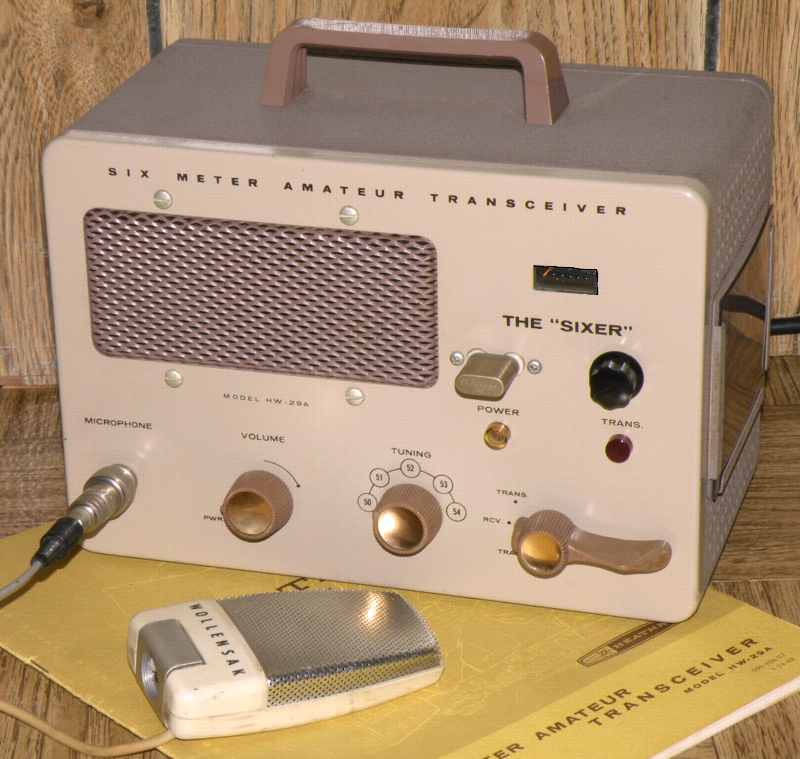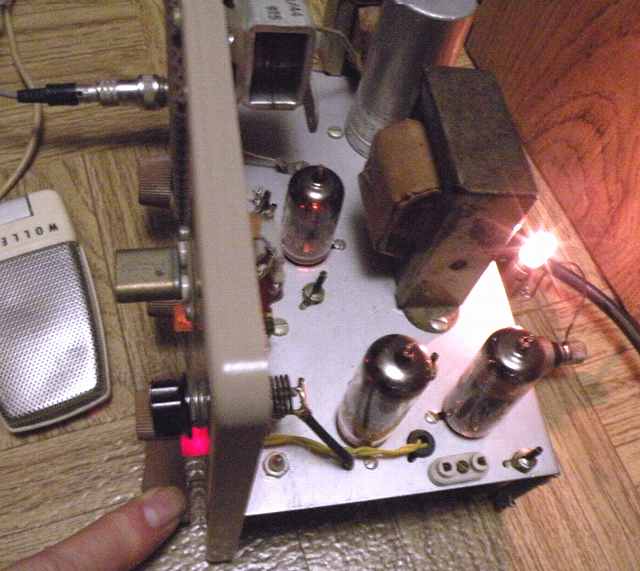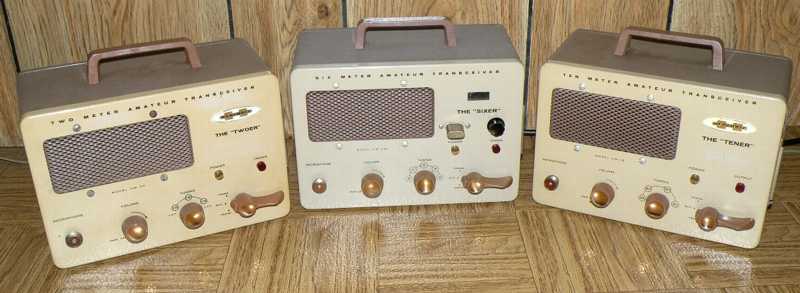
The HW-29A is the six meter version of the series affectionately known as a "Benton Harbor Lunchbox". The "Sixer", like most Heath products, originated life as a kit. The transmitter portion uses 8 MHz crystals for (X6) fixed frequency six-meter AM output while the receiver is tunable super-regenerative. Like the other Benton Harbor lunchbox transceivers, the Sixer can be operated from 115 VAC or from an external B+ supply and 6 or 12 volts DC.

Modifications
The Heath "Lunch box" series has my vote as the most likely to be modified of all Heathkit ham equipment. The majority of sets seem to be modified in some fashion, typically because the set needed to have the case removed to change crystals. A change in crystal also required re-tuning the transmitter while it was opened. Also, the original antenna connector was an RCA phono jack. While adequate for RF, it begged to be replaced by a more substantial SO-239. While metering for maximizing RF output was as simple as plugging in a VOM on the 50 volt scale via a phone plug on the rear mounted metering jack, some hams preferred a more permanent meter.
This example was modified so that crystals could be plugged into an added jack on the front panel and the final RF tuning could also be accomplished from the front. A very small permanent meter was attached to the panel in place of the plastic Heathkit logo. The modifications appear to be rather well thought out and neatly done, unlike some others I have seen. The set was purchased at a hamfest, (ham radio swap meet).
Repairs
The transceiver came without a power cord so I constructed one using a three wire recycled shielded computer power cord, connecting the green safety ground to pin 1 which connects to the chassis ground.
A "hum dinger"
Early testing was done with a power cord borrowed from one of my other "Lunch boxes". In testing, the transceiver appeared to be working but emitted a fairly strong hum and quit totally on an intermittent basis. I replaced the electrolytic capacitor doubler caps (100 MFD at 200 volts) with a pair rescued from an abandoned computer power supply. That helped with a bit of hum reduction. The rest of the hum originated in the audio preamp section, a dual triode 12AX7. Thinking I might be dealing with heater to cathode leakage, I swapped with a known-good tube. The hum persisted, actually to my relief since the 12AX7 that came with the Sixer was a new-looking Amperex "Bugle Boy" ECC83/ 12AX7 which tested fine. The Bugle Boy will find a more useful life in a high-end tube audio amp.
I left the replacemnt 12AX7 in the set and continued to troubleshoot. Replacing the cathode bypass electrolytic took care of much of the rest of the hum. I noticed that the filament line used the tabs on the chassis-mount electrolytic for connection to chassis ground. Tightening the ground screws and re-flowing the soldered ground connections on the chassis-mounted electrolytic also a helped a bit. However, some hum persisted and this portion was intermittent. I finally resorted to the oscilloscope, something I probably should have done earlier. The B+ was clean according to the scope.
The transceiver, when powered by AC, has a link in the power plug that grounds one side of the filament chain. I found a slight bit of hum on that line. When probing that line at the 12AX7 connection, the hum varied some depending upon how much I pressed on the scope probe with the scope showed a fairly strong hum signal that should not have been there. Sure enough, carefully checking the wires on that tube socket terminal revealed one wire that was tight but never soldered. After properly soldering that connection, both the intermittent hum and the occasional intermittent failure problem were solved.
Alignment of the receiver
I followed the alignment instructions in the Heath manual. There are two top-of-chassis adjustments for the receiver circuit. One adjusts the receive frequency so it matches the tuning dial. The other is the antenna adjustment to maximize receive sensitivity for weak signals. A rear-panel adjustment sets the regeneration level.

Dummy load bulb
I connected a light-bulb dummy load as indicated in the manual. However, Heath calls for a type #47 pilot bulb. A #47 is rated at 6 volts at 150 mA. I found that the #47 lit up so brightly that I was afraid of burning it out. I substituted a 12 volt bulb at 250 mA as dummy load.
Adjusting the transmitter
There are three adjustments for the transmitter circuit originally on the chassis. As noted, the adjustment for the final RF tube was relocated to the front panel in this example. The other two are for tuning the output of the doubler and the tripler as indicated by the brightness of the dummy load bulb. The doubler and the tripler have to be adjusted to maximize output for a given crystal and its frequency. Changing the crystal requires tweaking not only the final RF but also the doubler and tripler. With just the front panel final RF adjustment, any change in crystal would not provide maximum output especially if the crystals were significantly different in frequency. I assume the ham who modified the set had crystals that were close to each other in frequency. If not, he was not able to maximize RF output by just retuning the final.
Family gathering
The other ham-band transceivers in the Benton Harbor Lunch Box series, the HW-30 "Twoer" and the HW-19 "Tener", visited the shop to welcome the new Sixer.

On-the-Air reports
I checked into the local 6 meter net with the Sixer and Wollensak mike and was given excellent audio reports. The Sixer puts out only about 2 to 2.5 watts so the net members noticed I was running less power than normal but indicated no difficulty with reception. On receive, I noticed the Sixer had a bit less sensitivity than what I am used to in more complex superhet sets, but it was adequate for the task. Successfully using a relatively simple rig is a rewarding experience.
Try this link for Heathkit catalog info on the HW-29A and the other "Lunch Boxes".
9-01-09
A National Radio Institute (NRI) AM radio kit was the previous item on the bench.